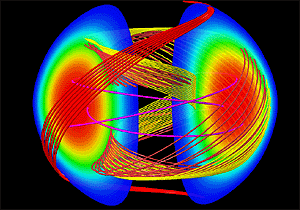Improved Algorithm Speeds Up Fusion Code by a Factor of 5
September 2, 2003
Developers of the NIMROD code, which is used to simulate fusion reactor plasmas, collaborated with members of the SciDAC Terascale Optimal PDE Simulations Center to implement the SuperLU linear solver software within NIMROD. As a result, NIMROD runs four to five times faster for cutting-edge simulations of nonlinear macroscopic electromagnetic dynamics — with a corresponding increase in scientific productivity.
The NIMROD project, funded by the DOE Office of Fusion Energy Sciences and the SciDAC Center for Extended Magnetohydrodynamic Modeling, is developing a modern computer code suitable for the study of long-wavelength, low-frequency, nonlinear phenomena in fusion reactor plasmas. These phenomena involve large-scale changes in the shape and motion of the plasma and severely constrain the operation of fusion experiments.

Full 3D numerical simulation of plasma particle drift orbits in a tokamak.
By applying modern computational techniques to the solution of extended magnetohydrodynamics (MHD) equations, the NIMROD team is providing the fusion community with a flexible, sophisticated tool which can lead to improved understanding of these phenomena, ultimately leading to a better approach to harnessing fusion energy. Since the beginning of the project, the NIMROD code has been developed for massively parallel computation, enabling it to take full advantage of the most powerful computers to solve some of the largest problems in fusion. The team's primary high-end computing resource is the 10 teraflop/s IBM SP (Seaborg) at the National Energy Research Scientific Computing (NERSC) Center at Lawrence Berkeley National Laboratory.
NIMROD's algorithm requires solution of several large sparse matrices in parallel at every time step in a simulation. The stiffness inherent in the physical system leads to matrices that are ill-conditioned, since rapid wave-like responses provide global communication within a single time-step. The preconditioned conjugate gradient (CG) solver that has been used was the most computationally demanding part of the algorithm, so Carl Sovinec of the NIMROD team consulted with the SciDAC Terascale Optimal PDE Simulations (TOPS) Center to find a replacement.
Conversations with David Keyes of Old Dominion University, Dinesh Kaushik of Argonne National Laboratory, and Sherry Li and Esmond Ng of Lawrence Berkeley National Laboratory pointed to SuperLU as a possibly more efficient matrix solver for NIMROD. SuperLU is a library of software for solving nonsymmetric sparse linear systems in parallel using direct methods.
It took less than a month to implement, test, and release SuperLU into the full NIMROD production code, and the performance improvements were dramatic. For two-dimensional linear calculations of MHD instabilities, NIMROD runs 100 times faster with SuperLU than it does with the CG solver. While linear calculations do not require supercomputer resources, they are extremely useful for preliminary explorations that help determine which cases require in-depth nonlinear simulations. For linear problems, this performance improvement makes NIMROD competitive with special-purpose linear codes.
For cutting-edge three-dimensional, nonlinear tokamak simulations (see figure), which require supercomputing resources, NIMROD with SuperLU runs four to five times faster than before. This improved efficiency yields four to five times more physics results for the same amount of time on the computer — a major improvement in scientific productivity.
The nonlinear simulations accumulate relatively small changes in the matrix elements at each time step, but there are no changes to the sparsity pattern. The NIMROD implementation allows SuperLU to reuse its factors repeatedly until the matrix elements accumulate a significant change and refactoring becomes necessary. Refactoring makes the performance improvement less dramatic in nonlinear simulations than in linear calculations, but it is still very significant.
The net result is that computationally demanding simulations of macroscopic MHD instabilities in tokamak plasmas, which until now were considered too difficult, have become routine.
This progress was made possible by SciDAC-supported algorithm research and NERSC computational power, confirming the SciDAC vision of computer scientists and application scientists working together to take full advantage of terascale computing systems.
Further information on NIMROD is available at http://www.nimrodteam.org/.
About NERSC and Berkeley Lab
The National Energy Research Scientific Computing Center (NERSC) is a U.S. Department of Energy Office of Science User Facility that serves as the primary high performance computing center for scientific research sponsored by the Office of Science. Located at Lawrence Berkeley National Laboratory, NERSC serves almost 10,000 scientists at national laboratories and universities researching a wide range of problems in climate, fusion energy, materials science, physics, chemistry, computational biology, and other disciplines. Berkeley Lab is a DOE national laboratory located in Berkeley, California. It conducts unclassified scientific research and is managed by the University of California for the U.S. Department of Energy. »Learn more about computing sciences at Berkeley Lab.







